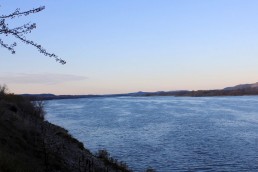Mississippi River Pool 13: Six-Pound Bass
SHARE THIS POST
The Mississippi River has been considered one of the better largemouth bass fisheries in Illinois for quite some time, but in the past decade, it has pushed itself to the top of the list. There are multiple tournaments on the pool each weekend, and 5-fish limits of 20 pounds or more are becoming the norm, not the exception. Largemouths exceeding 6 pounds are caught each weekende during May, particularly in an area called Spring Lake.
Let me attempt to give you an apples-to-apples comparison of over twenty high-quality bass waters across Illinois. The Illinois High School Association (IHSA) holds sectional bass tournaments statewide each spring, including at Big Slough Ramp, Pool 13, which is near the entrance of Spring Lake. This event brings in around 25 teams to compete, with many of the high school anglers having minimal experience.
In 2018, 21 pounds, 12 ounces won the sectional; in 2019, 19 pounds, 8 ounces. The cut for state final qualification from this sectional was 18-1 & 16-9, respectively, those two years. In comparison, nearly all the sectional winners across the state failed to catch even those cut-line weights. A quick run through the historical sectional results on the IHSA website seemingly confirms that the 21-12 limit is the largest bag ever recorded in a sectional across the state, and it came from Pool 13. This sectional location has also finished no worse than tied for second the past 4 years for the largest limits caught in the state. Eleven of the 22 boats that participated in the 2018 sectional brought at least 15 pounds to the scales. So, this is not a fluke; the bass are there!
The area most of these anglers were fishing is called Spring Lake, a habitat rehabilitation and restoration project (HREP) that was officially completed in 2002. This 3,300-acre lake and backwater complex is located approximately two miles south of Savanna, Illinois. The area is leveed, has no natural current flowing through it, and is also a highly important stopover area for migrating wildlife.
Are you enjoying this post?
You can be among the first to get the latest info on where to go, what to use and how to use it!
HREPs utilize a wide range of construction techniques and approaches that mimic natural river processes and provide benefits to the river system at the system, reach, pool and local scales. Designed, constructed and funded through the Army Corps of Engineers, they can be found from Minneapolis to St. Louis, and have improved the habitat wherever they had been conducted. While there have been numerous projects completed throughout the Upper Mississippi River, the Spring Lake project seems to stand out to the area fisherman, especially in spring. The area was originally drained and farmed. Now, the lake has multiple ditches, a large island, some deep holes, riprap shorelines, stump fields—basically a significant amount of diversity of habitats throughout. An aerial photo may look like an octagon-shaped lake with nothing but lily pads; however, when spring waters rise up, this lake continues to produce the largest sacks of largemouth bass the Mississippi River can produce.
Shallow-water fishing techniques used on the river are not unique. Most anglers will spend their time flippin’ wood with jigs or plastics, or throwing swim jigs, bladed jigs, spinnerbaits and buzzbaits around Spring Lake. Large swimbaits are becoming more fashionable the past few years, with many impressive 6-pound-plus fish being caught with this technique. Flooded wood, particularly button brush, is a popular place to start in April through mid-May, as male bass find areas to build their nests. The extensive stump fields that create havoc on unsuspecting outboard lower units are one of the reasons there is so much spawning habitat in the lake. Anglers will usually start by concentrating on the hard banks, usually levees, to find those fish. As the females begin moving up to the beds, 5-fish sacks approaching 25 pounds are brought to the scales, even in small tournaments.
As summer comes along, tactics change to flippin’ plastics, jigs and throwing smaller swimbaits and frogs. Having fished many tournaments in Pools 13 & 14, I can tell you that if the frog bite is going, Spring Lake is tough to beat for your 5 biggest bites of the day.
Many people remember the Mississippi River as the ol’ muddy river full of catfish and other rough fish. But if high school students are bringing in 20-pound limits to the scales, then it has to be one of the top fisheries in the Midwest.
MWO
SHARE THIS POST
Did you enjoy this post?
You can be among the first to get the latest info on where to go, what to use and how to use it!
Jeremiah Haas
As a full-time fisheries biologist on the Mississippi River, Jeremiah Haas is intimately tied to the outdoor resources surrounding the greater Quad Cities area and the Upper Mississippi River Basin. An accomplished hunter, fisherman and writer, Haas offers unique insight and perspective to MidWest Outdoors readers.



